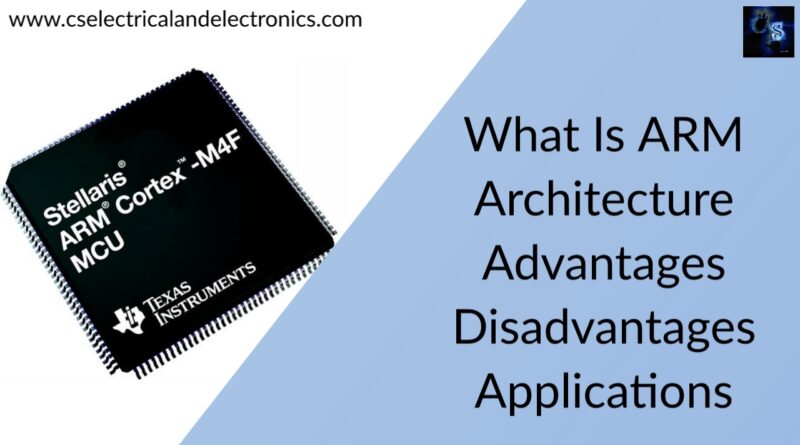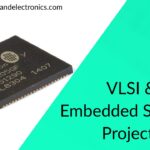What Is ARM, Architecture, Advantages, Disadvantages, Applications
Hello guys, welcome back to my blog. In this article, I will discuss what is ARM, architecture, working, advantages of ARM microcontroller, disadvantages, applications, etc.
If you have any doubts related to electrical, electronics, and computer science, then ask question. You can also catch me @ Instagram – Chetan Shidling.
Also, read:
- What Is A Deadlock In Operating System, How To Prevent Deadlock.
- What Is Electric Drive, Working, Applications, Advantages, Disadvantages.
- What Is Smart Grid, Working, Applications, Requirements Of Smart Grid.
What Is ARM
The ARM microcontroller stands for Advanced RISC Machine and is one of the world’s most widely used and licensed CPU cores. Cambridge University created the first ARM processor in 1978, and the Acorn Group of Computers created the first A-R-M RISC processor in 1985. Due to benefits such as low power consumption, reasonable performance, and other embedded systems, these processors are specifically utilized in portable devices such as digital cameras, mobile phones, home networking modules, wireless communication technologies, and other embedded systems.
This article provides an overview of the ARM architecture, including its benefits, drawbacks, and applications.
ARM Architecture:
The ARM architecture processor is a 32-bit reduced instruction set computer (RISC) microcontroller and is an advanced reduced instruction set computing [RISC] machine. It was first launched in 1987 by the Acron computer group. This ARM is a microcontroller family developed by companies such as ST Microelectronics, Motorola, and others. The ARM architecture is divided into several versions, such as ARMv1, ARMv2, and so on, each having its own set of advantages and limitations.
The ARM cortex is a complex microcontroller with an ARMv7 architecture that belongs to the ARM family. Within the ARM cortex family, there are three subfamilies:
- ARM Cortex Ax-series
- ARM-Cortex Rx-series
- ARM-Cortex Mx-series
Other components of the ARM processor include the Program status register, which stores the processor flags (Z, S, V, and C). The interrupt and quick interrupt disable bits, and the modes bits are stored in the program standing register. There are a few unique registers: Instructions, memory data read and write registers, and memory address registers are among the registers used.
ARM Microcontroller Register Modes:
An ARM microcontroller is a computer architecture with a load-store reducing instruction set, which means the CPU cannot directly access the memory. The registers must perform data operations, and the information is stored in memory using an address. The A-R-M cortex-M3 has 37 register sets, 31 of which are general purpose and 6 of which are status registers.
To carry out the user task, the ARM employs seven processing modes:
- USER Mode
- FIQ Mode
- IRQ Mode
- SVC Mode
- UNDEFINED Mode
- ABORT Mode
- Monitor Mode
01. USER Mode: The user mode is the simplest model, with the fewest registers. It lacks SPSR and has restricted access to the CPSR.
02. FIQ and IRQ: The CPU’s two interrupt-causing modes are FIQ and IRQ. The FIQ stands for processing interrupt, while the IRQ stands for standard interrupt. When crucial interruptions are handled, the FIQ mode has an extra five banked registers to enable more flexibility and excellent performance.
03. SVC Mode: The Supervisor mode is the processor’s software interrupt mode for a startup or reset.
04. Undefined Mode: When illegal instructions are executed, the Undefined mode traps them. A 32-bit data bus and quicker data transfer are part of the ARM core.
05. THUMB Mode: THUMB mode divides 32-bit data into 16-bits, increasing processing speed.
06. THUMB-2 Mode: THUMB-2 mode boosts the performance of the A-R-M Cortex –M3 microcontroller by allowing instructions to be either 16-bit or 32-bit. The ARM cortexm3 microcontroller uses only THUMB-2 commands.
In each mode, some registers are set aside for the core’s specialized use. The reserved registers are the following:
- Stack Pointer (SP).
- Link Register (LR).
- Program Counter (PC).
- Current Program Status Register (CPSR).
- Saved Program Status Register (SPSR).
Specific functions are performed in the reserved registers. The status control bits in the SPSR and CPSR are utilized to store the temporary data. Operating modes, interrupt enable or disable flags, and ALU status flags are all defined in the SPSR and CPSR registers. The ARM core can function in one of two modes: 32-bit or THUMBS.
Advantages of ARM Processor:
01. Created at a low cost– Because it does not require expensive equipment to manufacture, the A-R-M Processor is incredibly inexpensive. In comparison to other processors, it is produced at a far lower cost. As a result, they are well-suited to the production of low-cost mobile phones and other electronic gadgets.
02. Power consumption is low– The power consumption of AMP Processors is lower. They were created to perform at lower power levels. They even use fewer transistors in their design. They have several other qualities that make this possible.
03. Work more quickly– ARM only does one operation at a time. This speeds up the process. It has a smaller latency, which means it responds faster.
04. Feature of multiprocessing– ARM processors are designed to work with multiprocessing systems, which use many processors to process data. The first AMP processor, the ARMv6K, had the potential to handle four CPUs in addition to its hardware.
05. Improved Battery Life– The battery life of ARM processors is better. This can be seen while administering devices with and without ARM processors. Those who worked using ARM processors worked for longer periods of time and were discharged later than those
who did not.
06. The architecture of a load-store– The CPU employs a load-store architecture, which stores data in several registers (to reduce memory interactions). To transmit data between external memory and the register bank, it has distinct load and store commands.
07. Circuits Made Simple– Because A-R-M processors contain basic circuits, they are highly compact and may be employed in small devices (several devices are becoming smaller and more compact due to customer demands).
Disadvantages of ARM Processor:
01. Because it is incompatible with X86, it can’t be utilized with Windows.
02. Some processors have speed limitations, which could cause issues.
03. In the case of A-R-M processors, scheduling instructions are problematic.
04. The programmer’s instructions must be carried out correctly. This is because the execution of A-R-M processors determines their overall performance.
05. Programmers with a high level of expertise are required for the A-R-M processor. This is due to the significance and difficulty of the execution (processor shows the lesser performance when not executed properly).
Applications of ARM Processor:
Consumer electronic gadgets such as smartphones, tablets, multimedia players, and other mobile devices such as wearables all employ A-R-M processors. They require fewer transistors because of their restricted instruction set, allowing for a smaller die size for the integrated circuitry (IC).
To summarise, the above-mentioned article discusses A-R-M architecture, including its benefits, drawbacks, and applications. And it will undoubtedly aid you in the development of an A-R-M-based project.
I hope this article “What Is ARM” may help you all a lot. Thank you for reading.
Also, read:
- 100 + Electrical Engineering Projects For Students, Engineers
- 1000+ Electronics Projects For Engineers, Diploma, MTech Students
- 1000+ MATLAB Simulink Projects For MTech, Engineering Students
- 500+ Embedded System Projects For Engineer, Diploma, MTech, PhD
- 500+ Projects For Diploma Electrical, Electronics Student, Diploma Project
- 8051 Microcontroller Timers, TCON Register, TMOD Register
- Advancements In 3D Printing Technology And It’s Future
- Advancements In Power Electronics For Energy Efficiency
Author Profile
- Content Writer
Latest entries
 All PostsAugust 25, 2021Top 16 Highest Paying Engineering Jobs in the USA For Freshers
All PostsAugust 25, 2021Top 16 Highest Paying Engineering Jobs in the USA For Freshers All PostsAugust 23, 2021Top 10 Smart Cities In The World, Best Cities To Visit In The World
All PostsAugust 23, 2021Top 10 Smart Cities In The World, Best Cities To Visit In The World All PostsAugust 21, 2021Top 20 VLSI & Embedded Systems Projects for Mtech Students
All PostsAugust 21, 2021Top 20 VLSI & Embedded Systems Projects for Mtech Students All PostsAugust 21, 2021Top 20 Power Systems Projects For MTech Students, Engineering Students
All PostsAugust 21, 2021Top 20 Power Systems Projects For MTech Students, Engineering Students








